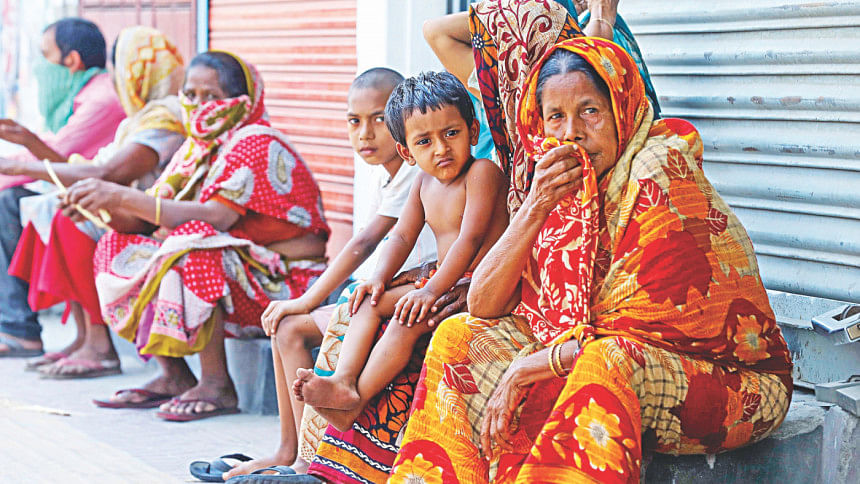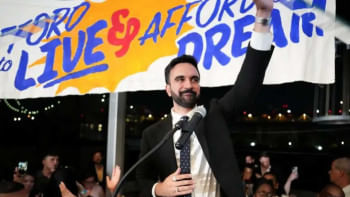Making the bell toll for the poor and the vulnerable

Are we doing enough to support households dependent on labour income from the formal and informal sectors in this time of distress?
The issue is particularly germane for the 125 million poor and vulnerable. For the vast majority of people in this category, labour is the only marketable endowment.
Let's assume the 6 million formal sector workers, who may not be poor but are surely vulnerable, are covered until the end of June by the Tk 72,750 crore concessional loan package announced so far for the formal sector, including large, medium and small enterprises in industry and services.
Assuming a 60:40 dependency ratio, this means 15 million poor and vulnerable have some sort of support.
The rest 110 million who depend on agriculture, construction, micro industrial enterprises and a whole variety of services in the informal sector are totally exposed to the vagaries of coronavirus.
Among them, the working population is about 44 million.
All of them are extremely distressed -- some more, some less, but distressed nonetheless. They are exposed to the risks of contracting the virus as well as enduring income losses.
It is important to recognise that for these 44 million workers, the trade-off is between the virus risk and hunger.
It is between the risk of suffering and dying by contracting coronavirus or bearing starvation pain, and even death, due to hunger if they stay home, where physical distance is a luxury for most.
Yet, staying home is surely better for the entire country and for them too if only it is economically bearable.
The question then is how much will it cost from the national budget to provide a minimum guaranteed income to the 44 million uncovered working people and their dependents during the crisis period?
In assessing the total fiscal cost of a guaranteed minimum income, we need to make assumptions about the length of the crisis period and the amount needed per capita per month.
What is a reasonable assumption about the length of the crisis period?
Even Anthony Fauci, the epidemic expert advising US President Donald Trump on the country's coronavirus response, cannot answer this question.
Whatever it is, it must include the time already elapsed. This is nearing a month now in Bangladesh.
The immediate question concerning the budget implementors is how much do we need to add to the fiscal 2019-20's budget?
If we assume, as seems plausible, the "sudden stop" period will not end by June, then for fiscal 2019-20's budget purposes, the crisis period is March-June, which is four months.
The minimum amount needed per capita per month can be derived from the national upper (UPL) and lower (LPL) poverty lines. These were respectively Tk 2,670 and Tk 1,865 in 2016/17. They need adjustment to account for inflation since 2016/17.
Using non-food and food inflation gives a range from which to pick the one that is affordable.
Based on the upper poverty line, this range is between Tk 3,088 to Tk 3,235 per capita per month. Based on the lower poverty line, it is between Tk 2,134 to Tk 2,234 per capita per month.
With 110 million beneficiaries, the total budget based on the UPL estimates ranges between Tk 135,872 crore to Tk 142,340 crore. The total budget has to be between Tk 91,096 crores to Tk 98,296 crores based on the LPL estimates.
The government has 1.7 per cent of GDP in its social protection budget for fiscal 2019-20.
The public social protection programmes are known to have large inclusion errors.
The impact of coronavirus may have corrected at least part of these errors by making the hitherto ineligible currently eligible because of income losses.
However, a large part of the budgetary provisions may have been spent already.
Assume for simplicity that about two months' equivalent of provision may still be available to pitch in to provide a guaranteed minimum income per capita per month to the uncovered poor and vulnerable. It amounts to about Tk 7,200 crore.
Subtracting this from each of the above estimates, the net additional amount ranges from a minimum of 3.3 per cent of GDP (non-food inflation-adjusted LPL) to a maximum of 5.3 per cent of GDP (food inflation-adjusted UPL).
These are indicative back-of-the-envelope estimates for budget makers to consider based on 110 million poor and vulnerable outside the formal sector.
The latter may appear too large compared with other estimates floating around ranging between 40 to 70 million.
The issue here is how many of the vulnerable do we exclude from the cash assistance because we think they are not as badly affected as those below them and there are resource constraints.
The silver lining from the lower estimates is that a lower effort in percentage of GDP -- say 1.2 to 1.9 -- is needed to help at least 40 million depending on which per capita level of assistance we choose.
There is no time to waste being too clever about the design of interventions, says the 2019 Nobel Laureate Esther Dufflo.
Let's zero-in on the minimum cash income guarantee for the poor and the vulnerable in the informal sector.
Cash social assistance is a widely used intervention chosen by 71 out of the 106 countries that have announced emergency responses to fight the poverty impact of coronavirus.
The logistical, social distance and governance challenges in delivering the food-based assistance and Tk 10 per kg rice through open market sales are becoming increasingly evident every day.
Whether it is 40 million or 110 million beneficiaries is something that can be gauged from learning by doing.
Yes, faced with collapsing tax revenues, any addition to the budget is an addition to the budget deficit.
However, faced with a human disaster, surely, we can find a way to finance it, if necessary, through deficit monetisation, as we are most likely to end up doing to finance the support announced for the formal sector.
As suggested by the 2019 Nobel Laureates Abhijeet Banerjee and Duflo, we need to be much bolder with the social transfer schemes. Direct funding of the additional fiscal transfers by the Bangladesh Bank is necessary to facilitate a speedy response.
The key implementation challenges are to identify the beneficiaries and deliver the assistance.
Preparing a completely new list based on means testing is not feasible in quick time.
The existing lists of beneficiaries in various social protection programs are good starting points.
It will need to be expanded to include all poor and vulnerable dependent on the informal sector.
Occupational and geographical targeting can substitute for means testing under the circumstances.
Agriculture, transport, hotels and restaurants, personal services and so on are good candidates.
We have the benefit of poverty maps based on 2016/17 Household Income and Expenditure data.
It should not be too difficult to identify the distressed using data available at the national and local levels and the local knowledge of the staff working for the local level government and non-government institutions.
Delivering assistance to workers who have no bank accounts or access to mobile financial services (MFS) is another challenge already highlighted by many even in the case of formal sector workers.
This number may not be as large as touted, but it is likely to be significant enough in the informal sector to warrant attention.
Instead of seeing it as a deterrent, it could be regarded as an opportunity to expand financial inclusion.
Let's do whatever is necessary to support bringing them into the MFS net using the 500,000 MFS agents that we currently have. Also, as far as I understand, about 80 per cent of the population above 18 years of age in Bangladesh have at least a paper ID.
The finance ministry needs to take the lead with other relevant ministries, parastatals, non-governmental organisations and MFS providers, as needed, to help reach cash assistance to the target groups.
While "testing, testing, testing" is the key to fighting coronavirus, "governance, governance, governance" is the key to delivering assistance to the poor and the vulnerable.
Lawrence Summers, a former chief economist of the World Bank and Treasury Secretary under former US President Bill Clinton, says that the first law of crisis response is to overreact rather than underreact.
This applies to both coronavirus containment and mitigation measures as well as measures to prevent the emergence of conditions undermining the effectiveness of the mitigation measures.
Without minimum social assistance, the hand-to-mouth poor and vulnerable people will have no choice but to defy orders.
Justifiably, one may worry about the impact on the prices of essentials after the cash transfers kick in.
Inflation generally should not be a concern in the present context if the reliance on deficit monetisation is strictly restricted to the duration of the emergency measures linked to the health crisis.
What would be important is to ensure that the supply chain of essentials remains functional and the stock of essentials available in the local markets is adequate. There is an overall contraction in domestic and export demand anyway.
The key priority to focus on now is the mitigation and containment of the virus spread, the consequent deepening of poverty and the spectre of hunger.
The author is an economist

 For all latest news, follow The Daily Star's Google News channel.
For all latest news, follow The Daily Star's Google News channel. 



Comments